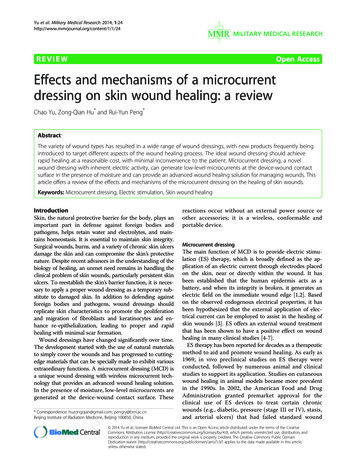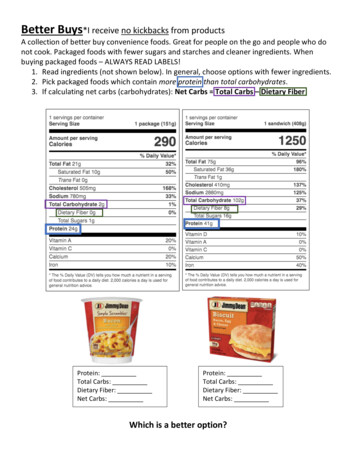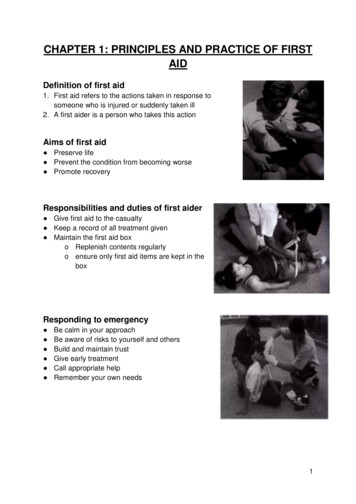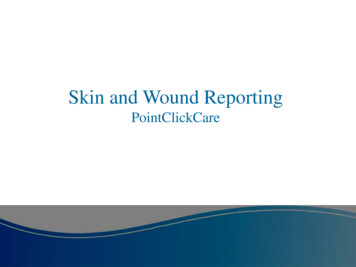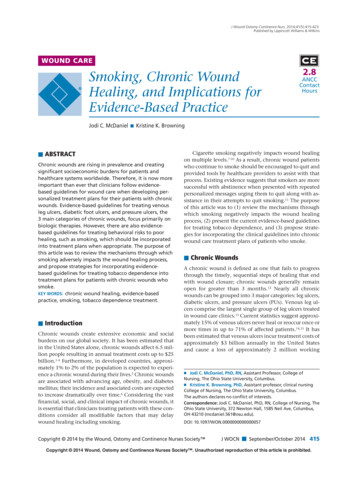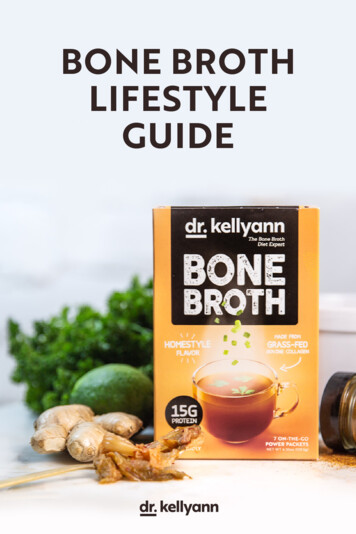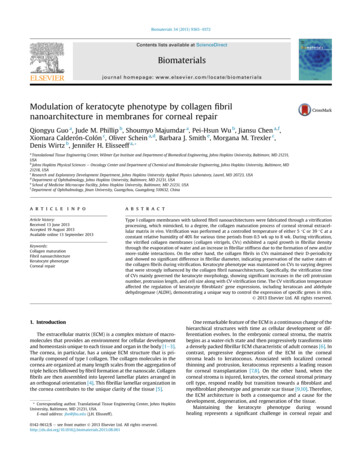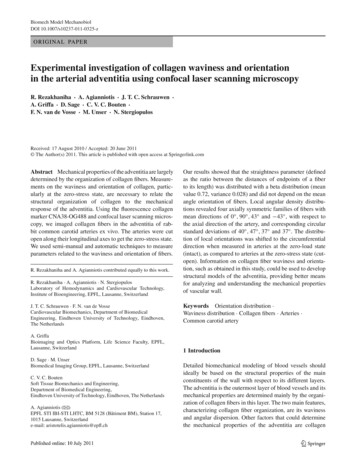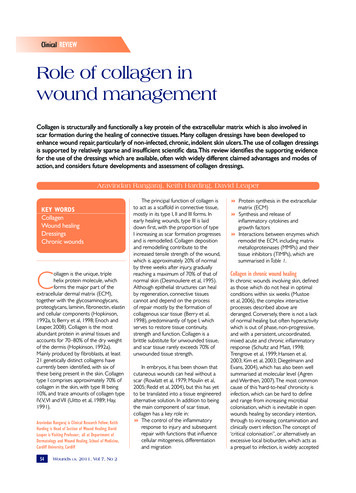
Transcription
Clinical REVIEWRole of collagen inwound managementCollagen is structurally and functionally a key protein of the extracellular matrix which is also involved inscar formation during the healing of connective tissues. Many collagen dressings have been developed toenhance wound repair, particularly of non-infected, chronic, indolent skin ulcers.The use of collagen dressingsis supported by relatively sparse and insufficient scientific data.This review identifies the supporting evidencefor the use of the dressings which are available, often with widely different claimed advantages and modes ofaction, and considers future developments and assessment of collagen dressings.Aravindan Rangaraj, Keith Harding, David LeaperKEY WORDSCollagenWound healingDressingsChronic woundsCollagen is the unique, triplehelix protein molecule, whichforms the major part of theextracellular dermal matrix (ECM),together with the glycosaminoglycans,proteoglycans, laminin, fibronectin, elastinand cellular components (Hopkinson,1992a, b; Berry et al, 1998; Enoch andLeaper, 2008). Collagen is the mostabundant protein in animal tissues andaccounts for 70–80% of the dry weightof the dermis (Hopkinson, 1992a).Mainly produced by fibroblasts, at least21 genetically distinct collagens havecurrently been identified, with six ofthese being present in the skin. Collagentype I comprises approximately 70% ofcollagen in the skin, with type III being10%, and trace amounts of collagen typeIV, V, VI and VII (Uitto et al, 1989; Hay,1991).Aravindan Rangaraj is Clinical Research Fellow; KeithHarding is Head of Section of Wound Healing; DavidLeaper is Visiting Professor; all at Department ofDermatology and Wound Healing, School of Medicine,Cardiff University, Cardiff54WoundsLeaper/Harding.indd 2uk,The principal function of collagen isto act as a scaffold in connective tissue,mostly in its type I, II and III forms. Inearly healing wounds, type III is laiddown first, with the proportion of typeI increasing as scar formation progressesand is remodelled. Collagen depositionand remodelling contribute to theincreased tensile strength of the wound,which is approximately 20% of normalby three weeks after injury, graduallyreaching a maximum of 70% of that ofnormal skin (Desmouliere et al, 1995).Although epithelial structures can healby regeneration, connective tissuescannot and depend on the processof repair mostly by the formation ofcollagenous scar tissue (Berry et al,1998), predominantly of type I, whichserves to restore tissue continuity,strength and function. Collagen is abrittle substitute for unwounded tissue,and scar tissue rarely exceeds 70% ofunwounded tissue strength.In embryos, it has been shown thatcutaneous wounds can heal without ascar (Rowlatt et al, 1979; Moulin et al,2005; Redd et al, 2004), but this has yetto be translated into a tissue engineeredalternative solution. In addition to beingthe main component of scar tissue,collagen has a key role in:8 The control of the inflammatoryresponse to injury and subsequentrepair with functions that influencecellular mitogenesis, differentiationand migration8 Protein synthesis in the extracellularmatrix (ECM)8 Synthesis and release ofinflammatory cytokines andgrowth factors8 Interactions between enzymes whichremodel the ECM, including matrixmetalloproteinases (MMPs) and theirtissue inhibitors (TIMPs), which aresummarised in Table 1.Collagen in chronic wound healingIn chronic wounds involving skin, definedas those which do not heal in optimalconditions within six weeks (Mustoeet al, 2006), the complex interactiveprocesses described above arederanged. Conversely, there is not a lackof normal healing but often hyperactivitywhich is out of phase, non-progressive,and with a persistent, uncoordinated,mixed acute and chronic inflammatoryresponse (Schultz and Mast, 1998;Trengrove et al, 1999; Hansen et al,2003; Kim et al, 2003; Diegelmann andEvans, 2004), which has also been wellsummarised at molecular level (Agrenand Werthen, 2007). The most commoncause of this ‘hard-to-heal’ chronicity isinfection, which can be hard to defineand range from increasing microbialcolonisation, which is inevitable in openwounds healing by secondary intention,through to increasing contamination andclinically overt infection. The concept of‘critical colonisation”, or alternatively anexcessive local bioburden, which acts asa prequel to infection, is widely accepted2011, Vol 7, No 216/06/2011 12:21
Clinical REVIEWbut is not accurately measurable (Whiteand Cutting, 2008). Nevertheless, controlof colonisation and infection throughlocal, topical (antiseptics) and systemic(antibiotics) antimicrobials is pivotal topreparation of the wound bed, beforewound closure following contractionthrough formation of ‘healthy’ granulationtissue and epithelialisation. Other factorscritical to the successful preparationof the wound bed include scrupulousdebridement of non-viable tissue andforeign material, by all methodologiesavailable (including sharp surgicaldebridement and topical negativepressure [TNP] therapy) (Wolcott etal, 2009). This can only be achieved inconjunction with optimal holistic care;again through local (such as attentionto adequate arterial supply or pressurerelief) and systemic (such as diabeticcontrol) interventions. Once thesecriteria are met, with a prepared woundbed and control of any underlyingpathological processes, successful healingcan occur. It is at this stage that collagenor collagen-derived dressings may have arole in wound healing strategies.Along with the critical collagenfunctions listed in Table 1, several otherfactors relating to poor wound healing,directly affect collagen metabolism.Included among the extrinsic factorsis diabetes, in which hyperglycaemiareduces normal collagen productionand induces non-enzymatic glycosylationof collagen and keratin, leading toformation of abnormal rigid collagenand adding to tissue breakdown (Blacket al, 2003). Collagen over productioncan form abnormal scars, which impedewound healing (Gault, 1999). A chronicwound burden among the elderly hasbeen documented (Wilkinson et al,1993), and much of this age-related,delayed wound healing is causedby impaired collagen synthesis andincreased degradation (Ashcroft et al,2002). Smoking affects the synthesisrates of collagen, MMP and TIMP1levels in the skin, leading to imbalancesin collagen turnover (Knuutinen etal, 2002). Intrinsic factors includevariations in oxygen tension whichcan alter fibroblast proliferation andcollagen production, and also enhancethe structural support required for56WoundsLeaper/Harding.indd 4uk,Table1Influence of collagen in the inflammatory response to injury8 Cellular differentiation, angiogenesis and mitogenesis8 Protein synthesis and ECM deposition8 Cellular migration (keratinocytes and epithelialisation, fibroblasts, monocyte/macrophages, neutrophils)8 Induction of collagenases8 Wound contraction8 Platelet aggregation and induction clotting cascades8 Induction of growth factors and cytokines through degradation products8 Cell surface receptors (integrins) in cell-signalling and induction of other ECM moleculesand proteinsReferences:Doillon and Silver, 1986; Montesano et al, 1983; Albini and Adelman-Grill, 1985; Newman and Tucci,1990; Petersen et al, 1990; Shaw et al, 1990; Klein et al, 1991; Schiro et al, 1991; Hynes, 1992; Madriand Marx, 1992; Scharfetter-Kochanek et al, 1992; Sudbeck et al, 1994; Krieg, 1995; Clark, 1996;Schultz and Mast, 1998; Pilcher et al, 1997, 1999; Feng et al, 1999; Davis et al, 2000; Steffensen etal, 2001; Armstrong and Jude, 2002; Ruszczak, 2003; Diegelmann and Evans, 2004; Mirastschijski etal, 2004; Schultz et al, 2005; Ulrich et al, 2005; Agren and Werthen, 2007; Cavallini, 2007; Clark et al,2007; Hodde and Johnson, 2007; DiCosmo, 2009; Schultz and Wysocki, 2009capillary angiogenesis (Hunt and Pai,1975), and an abnormal excessivelocal inflammatory response leadingto abnorma
serves to restore tissue continuity, strength and function. Collagen is a brittle substitute for unwounded tissue, and scar tissue rarely exceeds 70% of unwounded tissue strength. In embryos, it has been shown that cutaneous wounds can heal without a scar (Rowlatt et al, 1979; Moulin et al, 2005; Redd et al, 2004), but this has yet
